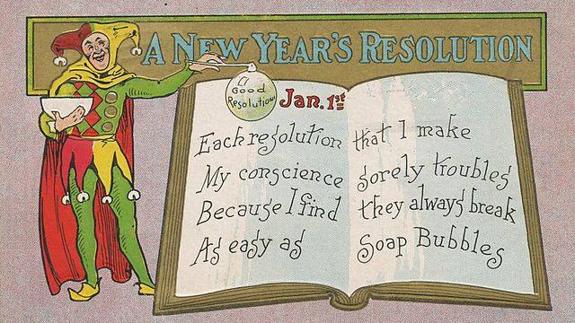New Year's resolutions: a 4,000-year-old pledge to self-improvement
It is believed that the Babylonians were the first to make New Year's resolutions around 4,000 years ago, and people all over the world have been making, and breaking, them ever since
Tony Bryant
Viernes, 29 de diciembre 2017, 18:48
As the old year comes to a close and we begin to embrace the new one, many of us will be thinking about our New Year's resolutions, even though the majority of them will have fallen by the wayside by the second week of January.
A New Year's resolution is a tradition most common in the Western Hemisphere in which a person resolves to change an undesired trait to accomplish a personal goal, or otherwise improve their life in the year ahead. Resolutions come in many forms and are usually undertaken to help one quit a bad habit such as smoking, while others make pledges to develop a positive approach to a strict exercise programme or learning a new language.
Religious parallels
During Judaism's New Year, Rosh Hashanah, one is to reflect upon one's wrongdoing over the year and seek and offer forgiveness. The concept, regardless of creed, is to reflect upon self-improvement annually.
It is believed that the Babylonians were the first to make New Year's resolutions around 4,000 years ago, and people all over the world have been making, and breaking, them ever since.
New Year's Day celebrations began in pre-Christian times, beginning with the Babylonians, who celebrated the New Year in March. March was a logical time for the New Year because spring begins and crops are planted. But the Babylonians had a greater motivation to stick to their promises than what we have today, because keeping their promise would mean that their gods would bestow their grace on them throughout the course of the following twelve months
The practice carried over into Roman times with worshippers offering resolutions of good conduct to the two-faced deity named Janus, the god of beginnings and endings who looks backward into the old year and forward into the new one. January is named after Janus, also the patron and protector of bridges, gates and doorways, and the Romans believed good luck would bless those who touched his head.
The Romans usually made resolutions with a moral flavor, but when the Empire accepted Christianity as its official state religion in the fourth century, the Feast of Circumcision began to be celebrated on January 1. The circumcision of Jesus has traditionally been seen as the first time the blood of Christ was shed, and thus the beginning of the process of the redemption of man.
Early Christian beliefs
Early Christians believed the first day of the New Year should be spent reflecting on past mistakes and resolving to improve oneself in the coming year. During watchnight services, many Christians prepared for the year ahead by praying and making these resolutions.
During the Medieval period, the Knights took the Peacock Vow. Supposedly, one by one, during the last feast of the Christmas week, the knights would place their hands on a roasted peacock and recommit themselves to the ideals of chivalry.
These noble birds perfectly represented the splendour and majesty of kings and their plumage was considered the richest ornament with which they could deck the crowns.
The Puritans
In the 17th century, the Puritans avoided the indulgences associated with Christmas and New Year's celebrations and they even avoided using the name January, instead, referring to it as the First Month.
The Puritans urged people to avoid the revelry and spend their time reflecting on the past year and contemplating the year to come. In this way, they adopted the old custom of making resolutions, but they were enumerated as commitments to better employ their talents, treat their neighbors with charity, and avoid their habitual sins.
The American revivalist preacher, philosopher and Protestant theologian, Jonathan Edwards, comprised a list of 70 resolutions on various aspects of life. These included never speaking anything but the pure and simple verity, never to speak evil of anyone, and to always maintain and establish peace.
Today, little has changed, but rather than making promises to gods, we make promises to ourselves. Since we cannot possibly rain the wrath of the gods down on ourselves as punishment for not keeping our promises, it need not surprise us that sooner or later we fail in staying true to our words.
Choosing realistic goals
A study carried out by the University of Bristol involving 3,000 people showed that 88 per cent of those who set New Year resolutions failed, despite the fact that 52 per cent of the study's participants were confident of success at the beginning.
The most common reason for participants failing their New Year's resolutions was setting themselves unrealistic goals and not keeping track of their progress, while one in ten respondents claimed they simply made too many resolutions.
So, when we have finished singing Auld Lang Syne -and bid farewell to the old year at the stroke of midnight - we should remember that when resolutions are too ambitious, we become discouraged when we fail and ultimately give up altogether.
It is claimed that resolutions are made to be broken, although we often rely on this premise to justify our failings.
So instead of making hard-line resolutions this year, try small, incremental resolutions, for they will have a much greater chance of creating real lifestyle change.
